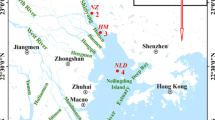Abstract
NIST maintains a portfolio of more than 1300 standard reference materials (SRM), more than a third of these relating to measurements in the biological and environmental fields. As part of the continuous renewal and replacement efforts, a set of new marine sediments has been recently developed covering organic and inorganic determinations. This paper describes the steps taken in sample preparation, homogeneity assay, and analytical characterization and certification with specific emphasis on SRM 2702 inorganics in marine sediment. Neutron activation analysis showed the SRM to be highly homogeneous, opening the possibility for use with solid sampling techniques. The certificate provides certified mass fraction values for 25 elements, reference values for eight elements, and information values for 11 elements, covering most of the priority pollutants with small uncertainties of only several percent relative. The values were obtained by combining results from different laboratories and techniques using a Bayesian statistical model. An intercomparison carried out in field laboratories with the material before certification illustrates a high commutability of this SRM.




Similar content being viewed by others
References
Lauenstein GG, Cantillo AY, Koster BJ, Schantz MM, Stone FS, Zeisler R, Wise SA (1996) National Status and Trends Program Specimen Bank: Sampling Protocols, Analytical Methods, Results, and Archive Samples. NOAA Technical Memorandum NOS ORCA 98, NOAA, Silver Spring, MD
Schantz MM, Benner Jr BA, Chesler SN, Koster BJ, Hehn KE, Stone SF, Kelly WR, Zeisler R, Wise SA (1990) Fresenius J Anal Chem 338:501–514
Schantz MM, Benner Jr BA, Hays MJ, Kelly WR, Vocke Jr RD, Demiralp R, Greenberg RR, Schiller SB, Lauenstein GG, Wise SA (1995) Fresenius J Anal Chem 352:166–173
Wise SA, Poster DL, Schantz MM, Kucklick JR, Sander LC, De Alda ML, Schubert P, Parris RM, Porter BJ (2004) Anal Bioanal Chem
Youden WJ (1969) In: Ku HH (ed) Precision measurements and calibration, statistical concepts and procedures. NBS Spec Publ 300, vol 1
Zeisler R (2000) J Radional Nucl Chem 245:81–85
Ingamells CO, Switzer P (1973) Talanta 20:547–568
Kurfürst U, Grobecker K-H, Stoeppler M (1984) Trace Elem 3:591–597
May WE, Gills TE, Parris R, Beck II CM, Fassett JD, Gettings RJ, Greenberg RR, Guenther FR, Kramer G, MacDonald BS, Wise SA (1999) Definitions of terms and modes used at NIST for value-assignment of reference materials for chemical measurements. NIST Special Publication 260–136; available athttp://www.cstl.nist.gov/nist839/NIST_special_publications.htm
Certificate of Analysis, SRM 2702 Inorganics in Marine Sediment, 3 December 2002. National Institute of Standards and Technology, Gaithersburg, MD; available athttp://ts.nist.gov/ts/htdocs/230/232/232.htm
Gelman A, Carlin JB, Stern HS, Rubin DR (1995) Bayesian data analysis. Chapman and Hall, London
ISO Geneva (1993) Guide to the expression of uncertainty in measurement, ISBN 92-67-10188-9, 1st edn, ISO, Geneva, Switzerland; see also Taylor BN, Kuyatt CE (1994) Guidelines for evaluating and expressing the uncertainty of NIST measurement results, NIST Technical Note 1297. US Government Printing Office, Washington, DC; available athttp://physics.nist.gov/Pubs/
Levenson MS, Banks DL, Eberhardt KR, Gill LM, Guthrie WF, Liu HK, Vangel MG, Yen JH, Zhang NF (2000) J Res Natl Inst Stan Technol 105:571–579
Willie S (2001) National Research Council Canada, Document No. 42746
Acknowledgements
Sincere thanks goes to all who contributed to the issuance of SRM 2702. Collection and preparation of SRM 2702 were performed by M.P. Cronise and C.N. Fales of the NIST Standard Reference Materials Program and B.J. Porter and M.M. Schantz of the NIST Analytical Chemistry Division. The sediment material was collected with the assistance of G.G. Lauenstein, J. Collier, and J. Lewis (National Oceanic and Atmospheric Administration). The contributions to value assignment of the members of Analytical Chemistry Division, National Institute of Standards and Technology: C.M. Beck II, T.A. Butler, M.E. Howard, R.M. Lindstrom, S.E. Long, E.A. Mackey, J.L. Mann, K.E. Murphy, R.L. Paul, J.R. Sieber, R. Spatz, R.D. Vocke, L.J. Wood, and L.L. Yu, and of the cooperating laboratories and analysts, the National Research Council Canada, Institute for National Measurement Standards, Chemical Metrology: S. Willie, J.W.H. Lam, C. Scriver, L. Yang, and the US Geological Survey: S.A. Wilson, M. Adams, P. Briggs, P. Lamothe, D. Siems, and J. Taggart, are gratefully acknowledged. Consultation on the statistical design of the experimental work and evaluation of the data were provided by M. Vangel and W.S. Liggett Jr. of the NIST Statistical Engineering Division.
Certain commercial equipment, instruments or materials are identified in this paper in order to specify the experimental procedures in adequate detail. Such identification does not imply recommendation or endorsement by the National Institute of Standards and Technology, nor does it imply that the materials or equipment identified are necessarily the best available for the purpose.
Author information
Authors and Affiliations
Corresponding author
Electronic Supplementary Material
Rights and permissions
About this article
Cite this article
Zeisler, R. New NIST sediment SRM for inorganic analysis. Anal Bioanal Chem 378, 1277–1283 (2004). https://doi.org/10.1007/s00216-003-2417-9
Received:
Revised:
Accepted:
Published:
Issue Date:
DOI: https://doi.org/10.1007/s00216-003-2417-9




